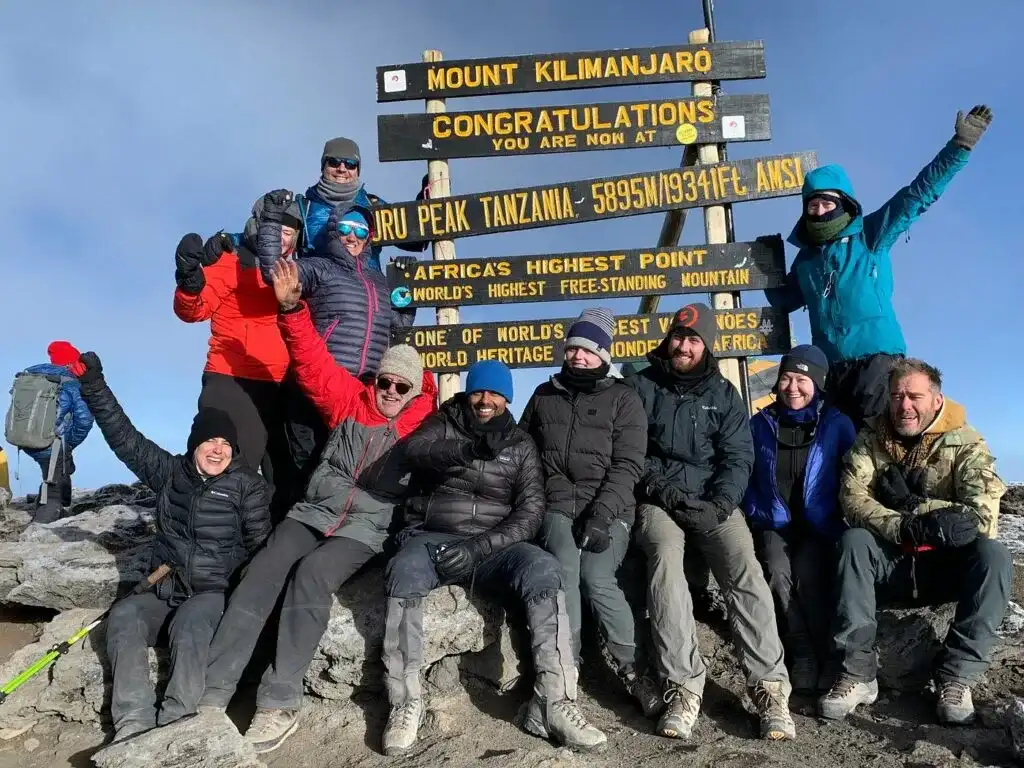Understanding Kilimanjaro's Summit Weather (Temperature)
Uhuru Peak, the highest point of Mount Kilimanjaro at 5,895 meters (19,341 feet), experiences extreme alpine weather. Temperatures at the summit can plummet to between -7°C (19°F) during the day and as low as -20°C (-4°F) or even colder at night. Wind chill can make it feel much colder, especially during summit night, which begins around midnight. The peak lies within the arctic zone of the mountain, where oxygen levels are roughly 49% compared to sea level. The combination of cold, wind, altitude, and dry air makes Uhuru Peak one of the most challenging environments on Earth. Proper clothing layers, gloves, headgear, and thermal protection are essential for a safe and successful summit.

What is the Temperature at Uhuru Peak?
The temperature at Uhuru Peak on Mount Kilimanjaro typically ranges between -7°C (19°F) during the daytime and can drop to -20°C (-4°F) or lower at night. With wind chill, the temperature can feel even colder. Climbers who summit at night or early morning face some of the coldest conditions on the entire trek.
1. Factors Affecting Temperature at the Summit
- Altitude: At nearly 5,900 meters, air pressure is low, and temperatures are arctic.
- Time of Day: Summit attempts begin at midnight, exposing climbers to the coldest part of the night.
- Wind Chill: Even moderate winds can make temperatures feel drastically lower.
- Season: Dry seasons (January–March and June–October) offer clearer skies but equally frigid summit temperatures.
2. Day vs. Night Temperature Comparison
During the day, when the sun is out, temperatures may rise slightly at the summit—sometimes up to -5°C (23°F). But most climbers reach Uhuru Peak at dawn, when it’s still freezing. Temperatures often range from:
- Nighttime (summit hours): -20°C to -10°C (-4°F to 14°F)
- Early morning: -10°C to -7°C (14°F to 19°F)
- Daytime (rare): -5°C to 0°C (23°F to 32°F)
3. Clothing Tips for Summit Night
Due to freezing temperatures at the top, layering is essential. Here"s what to wear:
- Base layers (thermal top and bottom)
- Fleece or down mid-layers
- Insulated jacket (down recommended)
- Waterproof outer shell (wind and snow protection)
- Thermal gloves, hat, and balaclava or neck gaiter
- Wool socks and insulated trekking boots
4. How to Handle the Cold at High Altitude
In addition to layering properly, you should also:
- Keep moving—rest breaks allow your body temperature to drop quickly
- Use hand and toe warmers if needed
- Drink warm fluids and eat energy-rich snacks
- Use trekking poles to maintain stability when icy winds hit
- Protect your water bottles from freezing by keeping them inside your jacket
5. Can the Cold at Uhuru Peak Be Dangerous?
Yes, exposure to subzero temperatures can lead to hypothermia and frostbite if climbers are not adequately prepared. Signs of cold-related issues include numbness, shivering, slurred speech, and extreme fatigue. Climbers must pay attention to their body’s signals and descend immediately if symptoms appear.
6. What Makes Summit Night the Coldest?
Summit night begins between midnight and 2 a.m. to allow trekkers to reach Uhuru Peak by sunrise. At this time, the sun is not present to warm the surroundings, wind speeds increase, and oxygen levels are at their lowest. These conditions create the harshest cold of the climb.
7. Temperature at Other Kilimanjaro Camps
As you ascend, the temperature drops drastically:
- Barafu Camp (4,673 m): -5°C to -10°C (23°F to 14°F) at night
- Karanga Camp: 0°C to -5°C (32°F to 23°F)
- Shira Camp: 5°C to -2°C (41°F to 28°F)
The temperature drop is most noticeable from Barafu to Uhuru Peak due to the elevation gain and wind exposure.
Frequently Asked Questions
How cold does it get at Uhuru Peak?
Temperatures typically range from -20°C to -7°C depending on the time of day and season. Wind chill can make it feel even colder.
Is it always freezing on the summit?
Yes. Even during the warmest months, the summit remains in the arctic zone with freezing conditions.
Do people suffer frostbite on Kilimanjaro?
It is rare, but possible. Most cases are avoided with proper gear and awareness of cold symptoms.
How should I prepare for summit night?
Dress in thermal layers, wear an insulated down jacket, protect your extremities, and use quality sleeping bags rated for -20°C or colder.
What time do climbers reach Uhuru Peak?
Most climbers reach the summit between 5:30 a.m. and 7:00 a.m., just after sunrise—during the coldest part of the day.
For expert Kilimanjaro trekking advice, contact us via WhatsApp: +255 678 992 599 or email jaynevytours@gmail.com.
BOOKING FORM
Book your tour here
RELATED PACKAGES
- Baraka Aquarium and Nungwi Village in Zanzibar
- Diving Tour in Zanzibar
- Zanzibar Sky Diving Tour
- Dolphin Snorkeling Sandbank Tour in Zanzibar
- Horse Riding Tour in Zanzibar
- Jet Ski Tour in Zanzibar
- Jozani Forest Visiting in Zanzibar
- Quad Bike Tour in Zanzibar
- Traditional Sunset Dhow Cruise Tour in Zanzibar
- The Best Stone Town Tour in Zanzibar
- Zanzibar Butterfly Tour
MORE PACKAGES
- Mount Kilimanjaro
- Ngorongoro Crater
- Serengeti National Park
- Tarangire National Park
- Lake Manyara National Park
- Zanzibar Island
- East Africa Packages
- Tanzania Safari From Zanzibar
- Kenya packages
- Rwanda Packages
- Uganda packages
- Mikumi National Park
- Kitulo National park
- Mkomazi National park
- Selous (Nyerere National Park)
